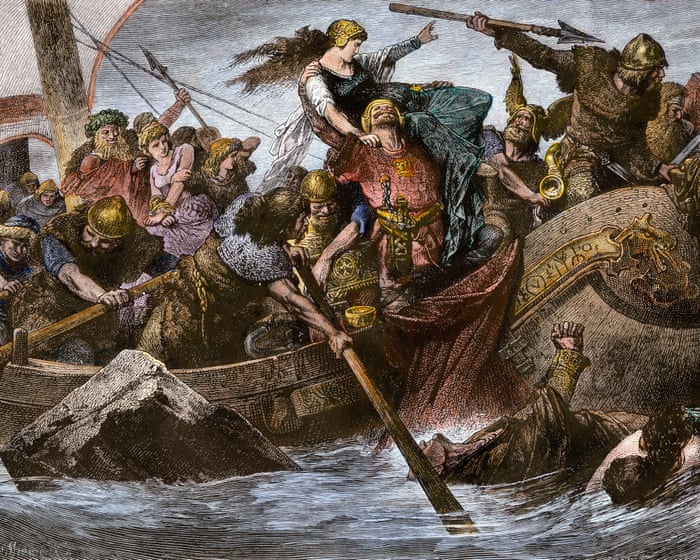“Hail Thor!” The priestess and her followers, standing in a circle, lifted their mead-filled horns. We had gathered in a simple clearing within a pine forest near Stockholm. This was our temple, and the large, moss-covered stone before us served as our altar. I was relieved to see that the sacrificial offerings were not live animals but rather long-dead and processed foods. A bearded man reached into his backpack with tattooed arms and raised a red, horseshoe-shaped sausage to the sky. A goth girl opened a plastic container of hammer-shaped cookies. The priestess handed me a few flaxseeds to scatter on the altar, which was already covered with gifts like apples and bottles of homemade mead.
About a dozen people had come together for an autumn sacrifice to honor Thor, the Norse god of harvests and storms, known for his mighty hammer. Many prayed for rain after a summer of severe drought. Others sought strength to overcome unemployment or healing for a sick mother. Each of us had our own reasons for being there. A middle-aged man in a sweaty office shirt seemed to be connecting with his bohemian wife and teenage daughter.
I attended because pagan events kept appearing in my Facebook feed, and I couldn’t understand why. I’m not spiritual or even agnostic—I’m firmly secular, appreciate modern medicine, and my social media usually reflects that. Having just returned to Sweden after five years in the UK, my online world was mostly filled with London friends and British humor. But there was a clear exception: my algorithm kept suggesting I explore local neo-Norse sacrifices. It hinted that this movement might be more mainstream than I thought, and the two ordinary-looking middle-aged women beside me in the forest seemed to confirm that—they could have been nursery workers. I never expected to come back to a Viking revival, nor did I anticipate it being so relaxed.
Sweden’s conversion to Christianity in the Middle Ages largely wiped out the pagan beliefs of the Viking era. Now, people are determined to revive them. While it’s far from a nationwide trend, this fringe faith has gained a notable following. Two recognized groups, the Nordic Asa-Community and the Community of Forn Sed Sweden, estimate they have around 2,700 members combined, though no official numbers exist. On Facebook, they have 16,000 followers together. They provide naming ceremonies, initiations, weddings, funerals, new holidays, and reasons to gather in forests and fields. With 20 local branches across Sweden, they organize small-scale sacrifices like the one I attended, and their annual national events reportedly draw about 300 participants.
This summer, Sweden approved its first new pagan burial ground in nearly a thousand years. Located next to a Christian cemetery in Molkom, it will feature three grass mounds shaped like buried ships. About 50 people have already requested burial there, with the site expected to open next year, according to the group behind the project. They’ve also raised 108,295 SEK (£8,740) to build a temple near Gamla Uppsala, once the heart of the Viking world. This shows the heathen community is serious about asserting their rights as a minority faith and about invoking Odin, the All-Father.
This is a surprising development in Sweden, a country often seen as highly secular, modern, and tech-savvy. History suggests it might signal an existential crisis. In the early 19th century, after Sweden lost Finland to Russia, writers and intellectuals turned to Viking legends to forge a new national identity centered on the brave, masculine Viking ideal to cope with the defeat. This image was later adopted by the Third Reich to promote Nazi ideas of Aryan superiority and racial purity, and it has been embraced by far-right movements.Groups still use runes and other Norse symbols today. Against this backdrop, it’s easy to assume that today’s pagan revival is linked to nationalism and Sweden’s new anti-immigration sentiment, and it’s impossible to know how many heathens hold such sympathies. Officially, Forn Sed is openly antiracist, and the NAC expelled one of its leaders in 2017 for allegedly making racist remarks. While reconnecting with lost traditions and ancestral heritage is a core tenet, both groups strongly emphasize respect for the natural world. Nordic animism, which reveres nature as sacred, has emerged as a significant new theology within the heathen community. Perhaps this ecological interpretation of Norse culture is a response to the current climate crisis, the effects of which—forest fires, water shortages, and floods—are becoming increasingly noticeable, even in the north. Restoring a half-extinct religion could offer a way to cope with climate anxiety and the fear that one’s way of life may soon be history, too.
Is Norse paganism here to stay? In Iceland, it has become the second-most practiced religion after Christianity, with 7,000 active members in a country of 387,000 people. Their temple in Reykjavik is set to open in 2026. In Denmark, where the movement claims to have over 3,500 believers, a pagan burial ground opened in 2009. Looking at Google Maps, it’s still standing. As of 2025, thirteen heathens have been laid to rest there, according to an email from the local municipality.
Though it’s easy to dismiss this new wave of Viking heathens as silly, we’re all guilty of obsessing about the past. Nostalgia runs through contemporary culture, whether it’s a fashion revival from the 2000s, sounds from the 70s, trad wives from the 50s, or pre-industrial homesteading. The pagans may look a bit more extreme with their rune-inscribed arms and braided beards, but their longing for permanence in an unstable world is not so different from our own.
Siri Christiansen is a Swedish investigative journalist based in Stockholm.
Frequently Asked Questions
Of course Here is a list of FAQs about Vikings returning to modern Sweden designed with clear natural questions and direct answers
General Beginner Questions
1 What does it mean that the Vikings have returned in Sweden
This is a fictional or metaphorical scenario It imagines that Vikings from the 8th11th centuries have suddenly reappeared in modernday Sweden and are trying to adapt to our contemporary world
2 Why are they seeking stability now
After being transported to a world with advanced technology different governments and global chaos their old way of life is no longer viable They are seeking a safe predictable and secure life just like anyone else
3 Are these the actual original Vikings
In this scenario yes They are the same people from the Viking Age with their original language skills and cultural beliefs which creates a major culture clash
4 What would be the biggest shock for them in modern Sweden
Almost everything would be a shock but the top ones would be digital technology the concept of a peaceful unified Sweden and the scale of globalization and multiculturalism
Adaptation Lifestyle Questions
5 How are they adapting to modern jobs and the economy
They would likely gravitate towards jobs that utilize their core skills such as blacksmithing carpentry sailing and shipbuilding security and outdoor guiding Learning about taxes and a digital currencybased economy would be a major hurdle
6 What modern conveniences would they appreciate the most
Indoor plumbing modern medicine reliable and abundant food sources and central heating would likely be seen as miraculous
7 What parts of modern life would they struggle with the most
They would struggle with bureaucracy the fast pace of life the concept of a digital identity and the sheer amount of information and noise in modern society
8 Are they trying to keep their old traditions alive
Yes many would fiercely hold onto their language their storytelling and craft skills However these traditions would inevitably blend with modern Swedish culture creating a new unique fusion
Social Cultural Questions




